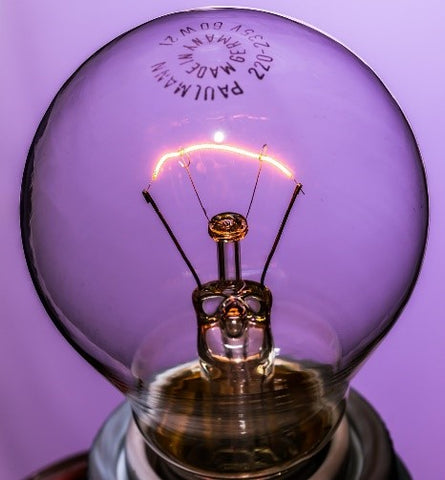When shopping light fixtures, people care most about if the lights are bright enough for their intended applications. The “brightness” that people refer to means the light visible to human eyes. Its scientific term is luminous flux. For a long time in my childhood, I was taught that the higher watts written on the bulb, the brighter it is.

Then came a rule breaker, the fluorescence lamp. Even though lower wattage, it is brighter than the previous lights. Later I came across more and more rule breakers, halogen lights, LED lights, HID lights, and so on. So, higher wattages don’t mean brighter. How do I find out their brightness?
The wattage, the measurement of the electric consumption, is the power input to the light fixture. The electric input does not fully convert to visible light (luminous flux). And the ratio of luminous flux output versus the electric input is called efficacy. The unit for luminous flux is lumen. So, the unit of efficacy is lumen/watt. The main reasons for the low conversion are due to the energy loss to the emitted invisible light and to the waste heat.
The time scale for lumen is one second. The lumen (lm) is the luminous flux that the light source emits per second. Lumen is derived from candela which is the International System of Units (SI) for light.
Different from lumen, candela takes emission angle into account and indicates the luminous intensity. It is the lumens in a steradian (sr). Steradian is a solid angle and there are 4pi (about 12.57) steradians in a sphere.

Each orange corn in above image is one steradian. 1 lumen = 1 candela x steradian.
Another commonly seen terminology is Lux. It adds area concept to lumen. 1 Lux = 1 lumen / m2. The further distance you move away from the light source, the lower Lux you get. Because the longer distance, the less light emission you receive in the same size area.
Here I am giving a simplified example. Let us say the light bulb

has 1257 lumens and radiates in all directions. Then its candela is 100 (because 1257 lumens/12.57 steradians = 100 candelas). Assume the cone reflector

is 3 steradians solid angle and reflects all lights (no energy loss), i.e., the luminous flux remains the same 1257 lumens. The luminous intensity – candela - increases to 419 (because 1257 lumens/3 steradians = 419 candelas). If a light hanging 10 ft above the ground gives 100 lumens in a square meter on the ground, it is 100 Lux on the ground. When the light is lifted up to 20 ft above the ground, the same square meter will receive 25 lumens and it is 25 lux. It is because when the height doubles, the radius of radiation (r) accordingly doubles. The area of radiation is pi*r2. So, the area becomes four time. The same lumens are distributed into four times size area. Each same size area receives a quarter of lumens.
After learning the terminologies, how do we know the lumens of the lights? First, look at their packages. It is an important spec and the manufacture often print it on the package. If not, look for product data sheet. For the measurements, a quite sophisticated instrument called integrating sphere is often used in the industries. The picture below shows the integrating sphere in our R&D lab. To measure luminous intensity, there are some hand-held instruments in the market, like Mavomonitor USB Luminance Meter. The most popular tools for lighting professionals are hand-held Lux meters. They are inexpensive and yield fairly accurate lux values. It is worth to note that the general Lux meters work best for incandescent lights. Due to their unique spectrum profiles, other light sources such as LEDs, HIDs, and fluorescent lights, will need Lux meters equipped with different silicon sensors or additional color correction factor treatments to achieve accurate results. For example, EXTECH has light meters specially designed for LED lights. By the way, there are some smartphone Apps claim to be able to use sensors in the smartphones to measure Lux values. However, quite a few articles and discussions questioned their accuracies.

Integrating sphere in LANGY
Reference
- https://sciencing.com/calculate-light-intensity-7240676.html
- https://www.lumitex.com/blog/light-measurement
- https://en.wikipedia.org/wiki/Steradian
- https://www.hotektech.com/luminance-candela-meter-mavomonitor.html
- https://growlightmeter.com/lux-meter-apps-why-id-only-use-photone/#:~:text=Unfortunately%20they%20aren't%20close,..%20you%20may%20trust%20them.
- https://photo.stackexchange.com/questions/15182/how-well-do-smart-phone-light-meter-apps-work
- https://migrolight.com/blogs/grow-light-news/par-meter-apps-compared-for-accuracy
- https://kw-engineering.com/dont-phone-smartphones-poor-substitutes-light-meters/

